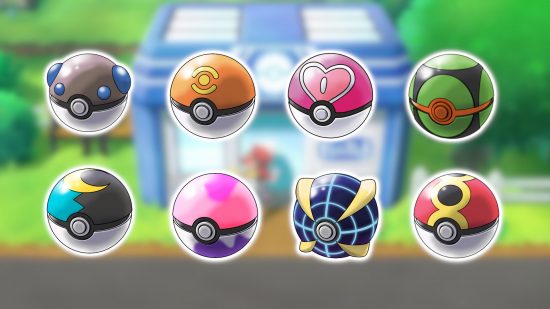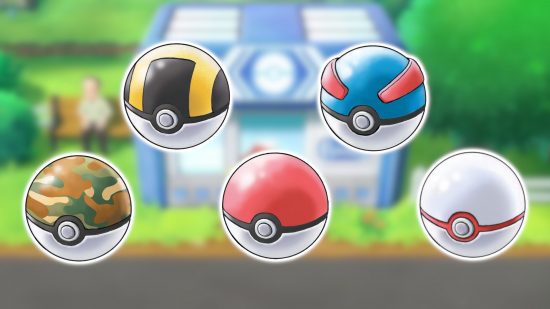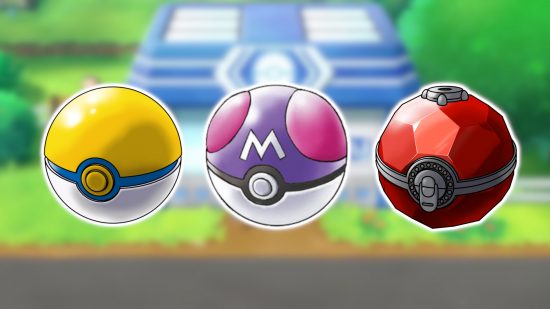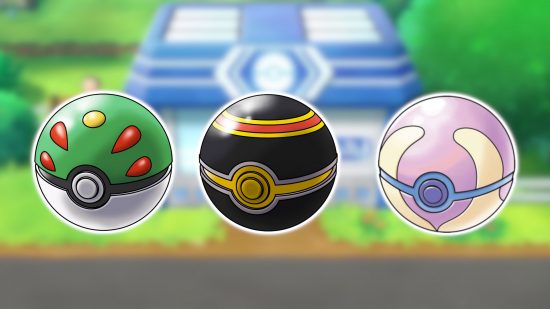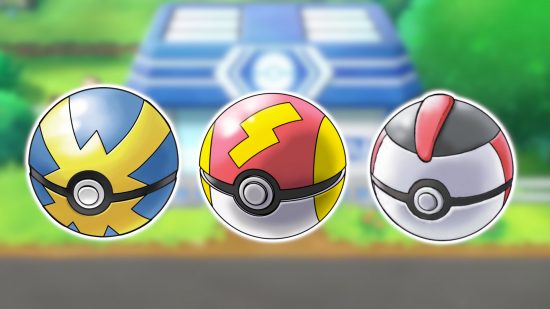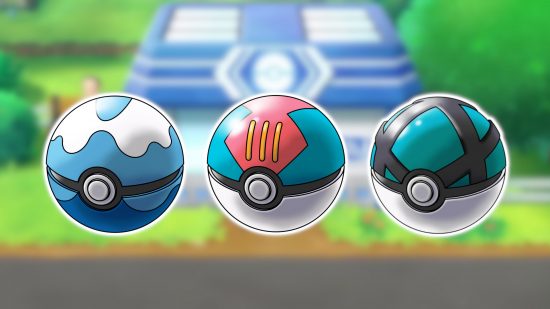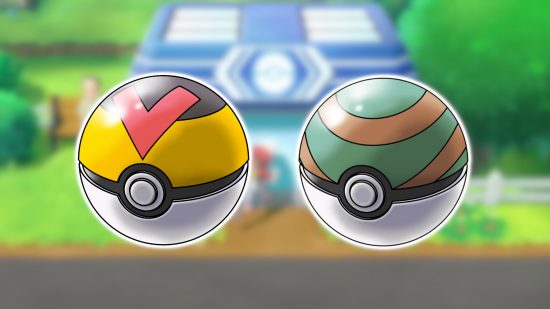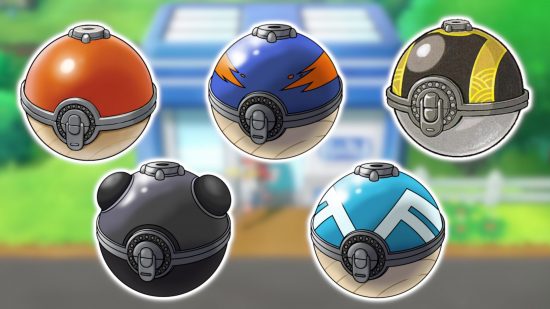If you’ve ever wondered which of the Pokéball types to use in a certain situation in Pokémon, we’re here to walk you through all of their different uses. There’s a lot of them, so prepare to take notes. Or bookmark this page so you always know which ball to use when. That’s probably a bit easier.
We at Pocket Tactics have a lot of opinions on Pokémon, and we think you should read them. So while you’re here, check out our guide to the best gen 5 Pokémon, the best mythical Pokémon, and the best starter Pokémon. See if you have the same opinions as us.
Now let’s get into all of the Pokéball types.
Standard Pokéballs
These are your basic balls made for catching Pokémon in the wild. They’re suitable for almost every situation you could find yourself in.
Poké Ball
The Poké Ball is the base standard for balls in the Pokémon franchise. Its classic red and white design is the most recognisable of all the balls, and it’s the first tool you get as an aspiring Pokémon trainer.
Great Ball
The Great Ball is a step up from the Poké Ball, with a 1.5x catch rate modifier compared to the Poké Ball’s base one. It’s good for catching those slightly stronger Pokémon or for using when you don’t want to knock the Pokémon’s health down too low.
Ultra Ball
The Ultra Ball is the next step up, offering a 2x catch rate modifier and a sleek black and yellow design. They’re great for using in the late game.
Premier Ball
There’s nothing special about Premier Balls other than their design. They’re essentially just reskinned Poké Balls, and their in-game description suggests they were made to commemorate an event.
Safari Ball
You used to only be able to use the Safari Ball in safari parks in certain Pokémon games, but as of the Pokémon Sword and Shield Isle of Armor DLC you can obtain and use it in regular gameplay.
Guaranteed capture Pokéballs
There are some balls that are guaranteed to catch any Pokémon you find, but they are hard to come by so make sure to use them wisely.
Master Ball
The Master Ball is the original guaranteed capture ball. You only get one of them and the assumption is that you use it to catch the game’s legendary Pokémon. In recent years it’s become a bit of a meme to use the Master Ball on a random weak Pokémon instead.
Park Ball
Generation four introduced this ball and it has a guaranteed capture rate when used in a Catching Show in Pal Park or Ramanas Park in Pokémon Brilliant Diamond Shining Pearl. This is part of the process for transferring Pokémon over from generation three games to generation four. Otherwise, it’s just a regular Poké Ball with a different colour palette.
Origin Ball
This ball is technically the in-universe precursor to the Master Ball. It’s used in the end game of Pokémon Legends: Arceus to automatically catch either Origin Forme Dialga or Palkia.
Caring Pokéballs
These Pokéballs show your Pokémon just how much you care about them!
Heal Ball
The Heal Ball does what it says on the tin really. It has a standard catch rate but when you catch a Pokémon in it, their HP and PP is fully restored and they’re cured of any status conditions. It’s like a Pokémon centre in your pocket! Plus, it has an adorable design in our opinion.
Luxury Ball
This ball has a top-notch design and is great for making your Pokémon feel special. It doubles the rate that the caught Pokémon’s friendship level increases, so it’s a great tool to have around when seeking those friendship-based evolutions, like some of the Eevee evolutions.
Friend Ball
If you can’t get your hands on a Luxury Ball, try the Friend Ball instead! It sets the Pokémon’s friendship level to 200 (or 150 in generation eight) so is also perfect for speeding up friendship-based evolutions.
Speed-based Pokéballs
Speed and timing can be essential to a successful Pokémon catch, especially when using these balls.
Quick Ball
This ball has a 5x catch rate modifier when used on the first turn of a battle so it’s great to use when completing your Pokédex, especially before you have access to False Swipe.
Fast Ball
Not to be confused with the Quick Ball, the Fast Ball’s success rate is dependent on the base speed of the Pokémon you’re catching. It’s four times better at catching a Pokémon if it has a base speed stat of 100 or more.
Timer Ball
This ball rewards you for taking your time in battle as it becomes more effective the more turns a battle takes. It maxes out at a 4x catch rate modifier after ten turns.
Water-based Pokéballs
Water-type Pokémon are a staple of the franchise, so there’s a range of balls designed specifically for catching them.
Lure Ball
Take this with you if you’re going fishing – it works four times better on Pokémon caught that way!
Dive Ball
This ball has a 3.5x catch rate modifier for water-dwelling Pokémon, so have some on hand for when you’re surfing on ocean routes.
Net Ball
The Net Ball works best on water-type or bug-type Pokémon, so it’s generally good to have on hand on various routes.
Level-based Pokéballs
If you’re struggling to catch some low-level Pokémon because your team is too hench, give these balls a go.
Level Ball
This is another great tool for completing your Pokédex. The Level Ball’s effectiveness increases depending on the level gap between your Pokémon and the wild Pokémon you’re trying to catch. If your ‘mon is four times higher level than the target, you have an eight times higher chance of success.
Nest Ball
The Nest Ball works similarly to the Level Ball but with more complicated maths and a lower level cap. Essentially, the bigger the level gap, the higher chance of success you have. The actual sum involved is ((41 – Pokémon’s level) ÷ ten)× if the Pokémon’s level is between one and 29.
Special condition Pokéballs
All of these balls have special conditions that make them more effective in certain situations or on specific Pokémon, but they didn’t fit into any of the previous groups.
Heavy Ball
As the name suggests, this ball’s effectiveness depends on the weight of the target Pokémon. If you like to collect absolute units, this is the ball for you.
Sport Ball
This ball has a 1.5x catch rate modifier and prior to generation eight, it could only be used during the bug catching contest.
Love Ball
Despite its super cute design, the catch requirements for this ball are a little outdated. It’s eight times more successful if the target Pokémon is the same species as your Pokémon, but a different gender.
Dusk Ball
The perfect weapon against a swarm of Zubats, the Dusk Ball is three times better at catching Pokémon in a cave or at night.
Moon Ball
This ball’s condition is really specific. The Moon Ball is four times better at catching Pokémon that use the Moon Stone to evolve. That includes Pokémon like Clefairy, Jigglypuff, and Munna.
Dream Ball
This ball is four times more effective at catching sleeping Pokémon than other balls. In generation five, it had a guaranteed capture rate but this has since been changed.
Beast Ball
This is a special ball design to catch Ultra Beasts. It has a 5x catch rate modifier when used on an Ultra Beast, and is the only ball aside from the Master Ball to not have a 0.1x catch rate modifier for Ultra Beasts.
Repeat Ball
This is another great ball for collectors and shiny hunters as it has a 3.5x catch rate modifier for Pokémon already registered as caught in your Pokédex.
Historic Pokéballs
Pokémon Legends: Arceus introduced us to the history of the Poké Ball in its current form, and showed us some other variants that would be quite handy today.
Hisuian Poké Ball, Great Ball, and Ultra Ball
These all work the same as their modern-day counterparts but with slightly different catch rates and a cool wooden design.
Feather, Wing and Jet Balls
These Hisuian balls were designed to travel further than standard Poké Balls and are more effective for catching Pokémon who are flying in the air.
Heavy, Leaden, and Gigaton Balls
A precursor to the modern-day Heavy Ball, these balls can’t be thrown far but work effectively on Pokémon that haven’t noticed you approaching.
There you have it, every Pokéball type and how to use them. If you need more tips on how to complete your Pokédex, check out our guides on how to evolve Pawmo, how to evolve Riolu, and how to evolve Qwilfish.
